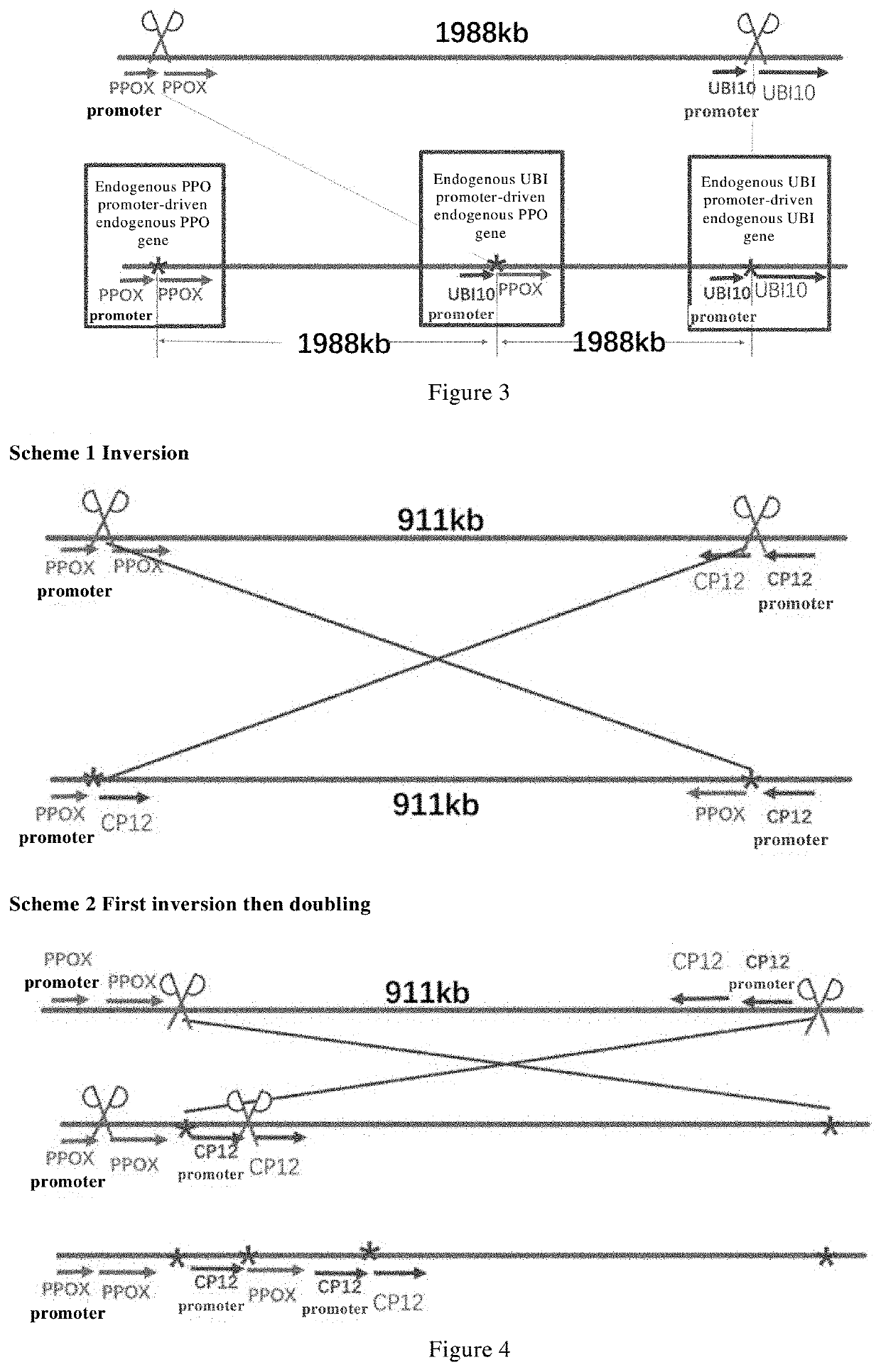Methods for generating new genes in organism and use thereof
a gene and organism technology, applied in the field of gene engineering and bioinformatics, can solve the problems of transgenic technology, loss of gene function, and difficulty in meeting some production needs, and achieve the effect of transgenic technology
- Summary
- Abstract
- Description
- Claims
- Application Information
AI Technical Summary
Benefits of technology
Problems solved by technology
Method used
Image
Examples
example 3
DETECTION AND HERBICIDE RESISTANCE TEST OF T1 GENERATION OF HERBICIDE-RESISTANT RICE STRAIN WITH KNOCK-UP EXPRESSION OF THE ENDOGENOUS HPPD GENE CAUSED BY CHROMOSOME FRAGMENT DOUBLING
[0257]The physical distance between the HPPD gene and the UBI2 gene in the wild-type rice genome was 338 kb, as shown in Scheme 1 in FIG. 1. The length of the chromosome was increased by 338 kb after the chromosome fragment between them was doubled by duplication, and a highly-expressing new HPPD gene was generated with a UBI2 promoter at the joint of the duplicated fragment to drive the expression of the HPPD CDS region. In order to determine whether the new gene could be inherited stably and the effect of the doubling chromosome fragment on the genetic stability, molecular detection and herbicide resistance test was conducted for the T1 generation of the HPPD doubled strains.
[0258]First of all, it was observed that the doubling event had no significant effect on the fertility of T0 generation plants, ...
example 4
G METHOD FOR KNOCKING UP THE EXPRESSION OF THE ENDOGENOUS PPO GENE BY INDUCING CHROMOSOME FRAGMENT INVERSION—RICE PROTOPLAST TEST
[0279]The rice PPO1 (also known as PPDX1) gene (as shown in SEQ ID NO: 7, in which 1-1065 bp was the promoter, the rest was the coding region) was located on chromosome 1, and the calvin cycle protein CP12 gene (as shown in SEQ ID NO: ID NO: 8, in which 1-2088 bp was the promoter, and the rest was the coding region) was located 911 kb downstream of the PPO1 gene with opposite directions. According to the rice gene expression profile data provided by the International Rice Genome Sequencing Project (http: / / rice.plantbiology.msu.edu / index.shtml), the expression intensity of the CP12 gene in rice leaves was 50 times that of the PPO1 gene, and the CP12 gene promoter was a strong promoter highly expressing in leaves.
[0280]As shown in Scheme 1 of FIG. 4, by simultaneously inducing double-strand breaks between the respective promoters and the CDS region of the tw...
example 6
DETECTION AND HERBICIDE RESISTANCE TEST OF THE T1 GENERATION PLANTS OF THE HERBICIDE-RESISTANT RICE LINES WITH KNOCK-UP EXPRESSION OF THE ENDOGENOUS PPO1 GENE THROUGH CHROMOSOME FRAGMENT INVERSION
[0306]The physical distance between the wild-type rice genome PPO1 gene and CP12 gene was 911 kb. As shown in FIG. 14, a highly-expressing PPO1 gene with a CP12 promoter-driven
[0307]PPO1 CDS region was generated on the right side after the inversion of the chromosome fragment between the two genes. A deletion of chromosome fragment could also occur. In order to test whether the new gene could be inherited stably and the influence of the chromosome fragment inversion on genetic stability, molecular detection and herbicide resistance test was carried out on the T1 generation of the PPO1 inversion strain.
[0308]First of all, it was observed that the inversion event had no significant effect on the fertility of the T0 generation plants, as all positive T0 strains were able to produce seeds norma...
PUM
 Login to View More
Login to View More Abstract
Description
Claims
Application Information
 Login to View More
Login to View More - R&D
- Intellectual Property
- Life Sciences
- Materials
- Tech Scout
- Unparalleled Data Quality
- Higher Quality Content
- 60% Fewer Hallucinations
Browse by: Latest US Patents, China's latest patents, Technical Efficacy Thesaurus, Application Domain, Technology Topic, Popular Technical Reports.
© 2025 PatSnap. All rights reserved.Legal|Privacy policy|Modern Slavery Act Transparency Statement|Sitemap|About US| Contact US: help@patsnap.com



